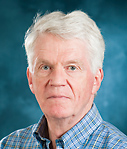In 1979, when he was a professor at Brown University, William Fulton solved a mathematical quandary known as Zariski’s problem.

Photo by Scott Galvin, U-M Photo Services.
He sent his work to the problem’s namesake, Oscar Zariski — a Russian-born mathematician who had laid the foundations of algebraic geometry and was at the time a rather old man.
“I still have the notes he sent me back,” Fulton says. “He was 80 years old, but he reacted in this wonderful, youthful way: the way a good graduate student would. He worked through every detail. He was very enthusiastic.”
Fulton, who now is the Oscar Zariski Distinguished University Professor of Mathematics and the M.S. Keeler II Professor of Mathematics, will discuss his interactions and admiration for Zariski in detail during his upcoming Distinguished University Professor lecture. The talk is at 4 p.m. April 6 in Rackham Amphitheatre.
Fulton will touch on Zariski’s life story and his contributions to algebraic geometry. By giving the field a foundation, Fulton says he helped to prove or disprove some of the work of the previous century.
“Algebraic geometry was done for 100 years without any foundation,” Fulton says. “They discovered things, but they weren’t able to prove them with the rigor we demand now. Once Zariski gave it a foundation, we could decide whether the things before were true or false and some were false.”
Algebraic geometry combines algebra and geometry into a field that interacts with physics and many areas of pure and applied mathematics, including number theory and topology. Zariski was able to combine the two areas due, in part, to his respect for new approaches.
“Most of the other mathematicians in that generation resisted when others wanted to go beyond what they had done,” Fulton says. “Zariski was marvelously open to all the things younger people were doing. For me, he’s a model of how a mathematician should be.”
Fulton himself has contributed to the field Zariski helped to cultivate. In January, he received the 2010 American Mathematical Society’s Leroy P. Steele Prize for Lifetime Achievement. He was honored for strengthening ties between algebraic geometry and adjacent fields as well as for nurturing generations of younger mathematicians.

